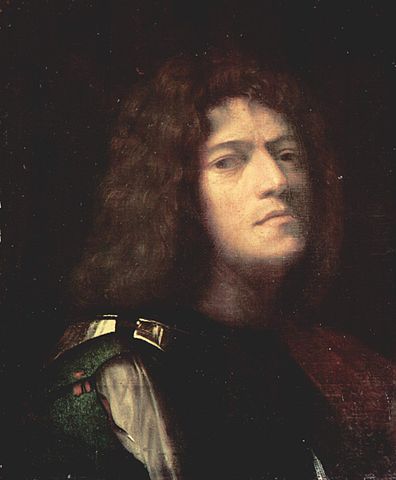
Born: 1477-78 or 1473-74, Castelfranco Vento, Venice
Died: 1510 (aged 31-37)
Period: High Renaissance
The Life of Giorgione
Giorgione, born Giorgio Barbarelli da Castelfranco around 1477-1478 in the small town of Castelfranco Veneto, near Venice, was an Italian painter who played a significant role in the Venetian Renaissance. Despite his relatively short life, passing away in his early 30s in 1510, Giorgione’s impact on the Renaissance was profound, marked by his innovative approach to color, light, and atmosphere, which would influence generations of artists, including Titian, who is believed to have been his pupil or collaborator.
Little is known about Giorgione’s life, and only a handful of his works have been securely attributed to him, partly because he left many of his paintings unsigned and because his brief career was overshadowed by the lack of documentation. However, the works attributed to him reveal an artist of remarkable sensitivity and skill, particularly in his approach to landscape and portraiture.
Giorgione’s painting style is characterized by its poetic and evocative quality, with a strong emphasis on mood and ambiance. He was one of the first to use the technique of sfumato, the subtle blending of colors and tones, which gives his paintings a dreamy and enigmatic quality. His subjects, often imbued with a sense of mystery, range from religious and mythological scenes to portraits and pastoral landscapes, all marked by a deep humanity and a naturalistic depiction of light and shadow.
Among his most famous works are “The Tempest,” a mysterious landscape that features a stormy backdrop with a nude woman nursing a baby and a clothed man; “The Three Philosophers,” a scene that has been subject to various interpretations; and “The Sleeping Venus,” which showcases his mastery of the female form in a landscape setting, a work that was completed by Titian after Giorgione’s death.
Giorgione’s influence extended beyond his immediate contemporaries to shape the future direction of Venetian painting. His innovative use of color and atmosphere would be developed further by Titian, who became the most famous Venetian painter of the 16th century. Despite the scarcity of his works and the mystery surrounding his life, Giorgione remains a pivotal figure in the history of Renaissance art, celebrated for his ability to convey emotion and atmosphere through the medium of paint.
Giorgione’s Notable Works
Giorgione, a seminal figure of the High Renaissance in Venice, left a profound impact on the art world despite his brief career. His works are celebrated for their innovative approach to color, composition, and atmospheric perspective. Here are ten of Giorgione’s most famous and significant works, though it’s important to note that attributions have been debated among scholars due to the limited number of documented works and the shared stylistic elements with contemporaries like Titian.
- The Tempest (c. 1508) – This enigmatic painting depicts a stormy landscape with a nude woman nursing a baby and a fully dressed man, surrounded by ruins. Its meaning remains a subject of speculation.
- The Three Philosophers (c. 1509) – Often interpreted as representing three ages of man or three philosophers in search of the source of light (or truth), this work is noted for its deep, atmospheric landscape and thoughtful composition.
- Sleeping Venus (c. 1510) – This groundbreaking reclining nude, completed by Titian after Giorgione’s death, influenced the development of the genre. Its serene landscape and soft, luminous figure highlight Giorgione’s mastery of form and atmosphere.
- Castelfranco Madonna (c. 1504) – Also known as the “Madonna and Child Between Saints Francis and Nicasius,” this altarpiece combines sacred figures with a detailed landscape, showcasing Giorgione’s skill in integrating figures with their environment.
- The Adoration of the Shepherds (c. 1505-1510) – Known as “La Notte” or “The Night,” this nativity scene is celebrated for its nocturnal setting and the innovative use of light to illuminate the figures, conveying a sense of intimacy and divine revelation.
- Laura (c. 1506) – This portrait of a young woman, possibly a courtesan, veiled with laurel leaves, is admired for its delicate beauty and the subtle modeling of the face and drapery, reflecting Giorgione’s interest in capturing the nuances of human expression.
- The Old Woman (c. 1508-1510) – Also known as “La Vecchia,” this portrait of an elderly woman holding a scroll with the inscription “Col Tempo” (With Time) is a poignant meditation on aging, marked by its realism and psychological depth.
- The Trial of Moses (c. 1500-1501) – This fresco, part of a series in the Fondaco dei Tedeschi in Venice, depicts scenes from the life of Moses. Though much of Giorgione’s fresco work has not survived, this piece offers insight into his early narrative style.
- Judith (c. 1504) – Attributed to Giorgione, this painting of Judith holding the head of Holofernes combines elements of portraiture with a biblical story, noted for its dramatic intensity and the complex expression of its subject.
- Pastoral Concert (c. 1509) – Though attribution is debated, this work is often associated with Giorgione (and possibly Titian). It depicts two clothed men and two nude women in a landscape, embodying the pastoral ideal and the harmony between humanity and nature, a theme that resonates throughout Giorgione’s oeuvre.
Giorgione’s work, characterized by its poetic ambiance and nuanced exploration of the human condition, played a crucial role in the development of Venetian painting and left a lasting legacy in the history of art.